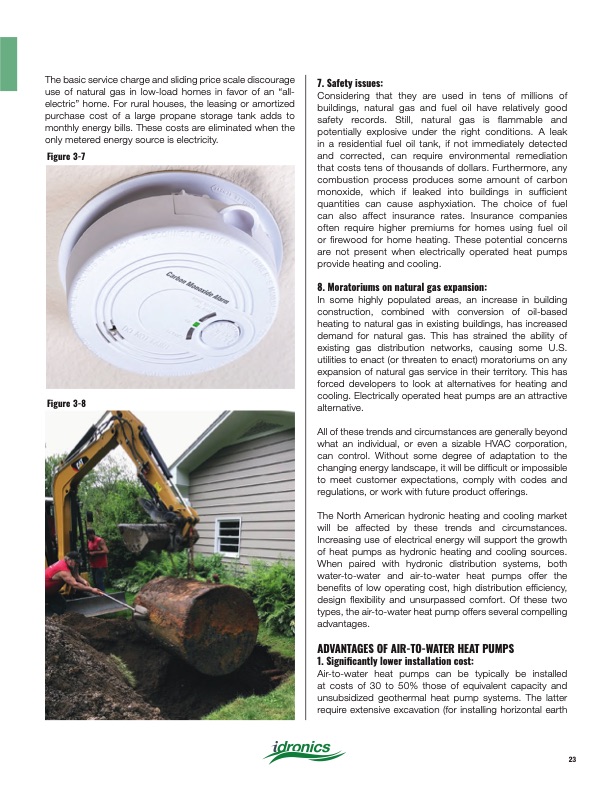
PDF Publication Title:
Text from PDF Page: 023
The basic service charge and sliding price scale discourage use of natural gas in low-load homes in favor of an “all- electric” home. For rural houses, the leasing or amortized purchase cost of a large propane storage tank adds to monthly energy bills. These costs are eliminated when the only metered energy source is electricity. Figure 3-7 Figure 3-8 7. Safety issues: Considering that they are used in tens of millions of buildings, natural gas and fuel oil have relatively good safety records. Still, natural gas is flammable and potentially explosive under the right conditions. A leak in a residential fuel oil tank, if not immediately detected and corrected, can require environmental remediation that costs tens of thousands of dollars. Furthermore, any combustion process produces some amount of carbon monoxide, which if leaked into buildings in sufficient quantities can cause asphyxiation. The choice of fuel can also affect insurance rates. Insurance companies often require higher premiums for homes using fuel oil or firewood for home heating. These potential concerns are not present when electrically operated heat pumps provide heating and cooling. 8. Moratoriums on natural gas expansion: In some highly populated areas, an increase in building construction, combined with conversion of oil-based heating to natural gas in existing buildings, has increased demand for natural gas. This has strained the ability of existing gas distribution networks, causing some U.S. utilities to enact (or threaten to enact) moratoriums on any expansion of natural gas service in their territory. This has forced developers to look at alternatives for heating and cooling. Electrically operated heat pumps are an attractive alternative. All of these trends and circumstances are generally beyond what an individual, or even a sizable HVAC corporation, can control. Without some degree of adaptation to the changing energy landscape, it will be difficult or impossible to meet customer expectations, comply with codes and regulations, or work with future product offerings. The North American hydronic heating and cooling market will be affected by these trends and circumstances. Increasing use of electrical energy will support the growth of heat pumps as hydronic heating and cooling sources. When paired with hydronic distribution systems, both water-to-water and air-to-water heat pumps offer the benefits of low operating cost, high distribution efficiency, design flexibility and unsurpassed comfort. Of these two types, the air-to-water heat pump offers several compelling advantages. ADVANTAGES OF AIR-TO-WATER HEAT PUMPS 1. Significantly lower installation cost: Air-to-water heat pumps can be typically be installed at costs of 30 to 50% those of equivalent capacity and unsubsidized geothermal heat pump systems. The latter require extensive excavation (for installing horizontal earth 23PDF Image | Heat Pump Systems 2020

PDF Search Title:
Heat Pump Systems 2020Original File Name Searched:
idronics_27_na.pdfDIY PDF Search: Google It | Yahoo | Bing
CO2 Organic Rankine Cycle Experimenter Platform The supercritical CO2 phase change system is both a heat pump and organic rankine cycle which can be used for those purposes and as a supercritical extractor for advanced subcritical and supercritical extraction technology. Uses include producing nanoparticles, precious metal CO2 extraction, lithium battery recycling, and other applications... More Info
Heat Pumps CO2 ORC Heat Pump System Platform More Info
| CONTACT TEL: 608-238-6001 Email: greg@infinityturbine.com | RSS | AMP |